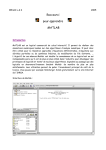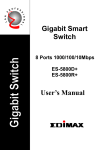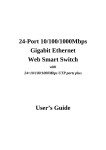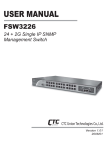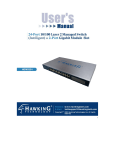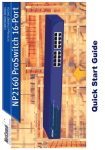Download Edimax ES-5224R+ network switch
Transcript
24-Port Fast/Gigabit Ethernet Smart Switch (VLAN, Trunking, QoS) ES-5224R+ ES-5224RF+ ES-5224RE+ ES-3124RE+ User’s Manual FCC COMPLIANCE STATEMENT This equipment has been tested and found to comply with the limits of a Class A computing devices, pursuant to Part 15 of the FCC rules. These limits are designed to provide reasonable protection against harmful interference. This equipment generates, uses and can radiate radio frequency energy and, if not installed and used in accordance with the instructions, may cause harmful interference to radio communications. If you suspect this product is causing interference, turn your computer on and off while your radio or TV is showing interference. If the interference disappears then when you turn the computer off and reappears then you turn the computer on, something in the computer is causing interference. You can try to correct the interference by one or more of the following measures: 1. Reorient/relocate the receiving antenna. 2. Increase the separation between the equipment and receiver. 3. Connect the equipment into an outlet on a circuit difference from that to which the receiver is connected. 4. Ensure that all expansion slots (on the back or side of the computer) are covered. Also ensure that all metal retaining brackets are tightly attached to the computer. 1 Content 1. Introduction ......................................... 3 2. Features & Specifications ................... 4 3. Package Contents................................. 6 4. Hardware Description......................... 7 5. Advance Smart Function Setting ..... 9 5.1 Main Manu....................................... 11 5.2 Switch Static Configuration ........... 13 5.2.1 Port Configuration...................... 14 5.2.2 Trunk Configuration................... 16 VLAN Configuration ................. 17 5.2.3 5.2.3.1 VLAN Configure....................18 5.2.3.2 Create a VLAN Group...........20 5.2.3.3 Edit/Delete a VLAN Group ...22 5.2.4 Misc Configuration .................... 23 SW version.............................23 5.2.4.2 Change User Name ...............24 5.2.4.3 Change User Password.........24 5.2.5 5.2.4.1 5.3 Priority Configuration ................ 25 Reboot Switch ................................ 26 5.3.1 Default ........................................ 26 5.3.2 Reset ........................................... 27 6. Troubleshooting ................................. 28 2 1. Introduction Congratulations on your purchase of this Fast/Gigabit Ethernet Smart Switch. This high performance smart switch provides Ethernet ports to segment network traffics, extend Ethernet connection distance, and convert data packets between different transmission speeds. This switch utilizes stored-and-forward switching architecture that filters and forwards data after the complete data packet is received and examined to be free of errors. With one set of status LEDs for each individual port, the switch operation status can be easily monitored. All the Fast Ethernet ports support both Full and Half duplex mode which are able to provide up to 200Mbps (2000Mbps for Gigabit Ports) of bandwidth to the connected devices, with auto-negotiation providing the capability to connect to 100/10Mbps(1000/100/10Mbps for Gigabit ports) network devices. It also supports backpressure and IEEE 802.3x advanced flow control capabilities that can reduce congestion and prevent packet loss. And it offers advance features: VLAN: Port-based and Tag-based VLAN allow you to set virtual LANs within your network Trunking: Reduce the bottleneck between switches QoS: Two priority queues per port allow you to define which port has higher priority. Expansion Slot Option: Provides copper or fiber (multi/single mode) module option In addition, all the ports support the MDI/MDI-X auto-detect function. That is to say, you can connect any device (including PC, Switch, Hub) to a port of this switch using a regular cable. The RJ-45 port will auto-detect and auto-switch to the correct MDI/MDI-X mode (do not need to use a specific uplink port or cross-over cable). 3 2. Features & Specifications Features Complies with the IEEE802.3 Ethernet, IEEE802.3u Fast Ethernet (IEEE802.3z, IEEE802.3ab for Gigabit switch) Provides Store-and-Forward architecture and full wire speed filtering and forwarding rates 10/100Mbps Ports support full/half duplex modes and auto-negotiation Provides two Fast Ethernet Modules option (Fast Ethernet Smart Switch): ♦ 100/10Mbps UTP connector (RJ-45) ♦ 100Mbps Fiber SC/ST connector (multi/single mode) Provides two Gigabit Ethernet Modules option (Gigabit Ethernet Smart Switch only): ♦ 1000/100/10Mbps UTP connector (RJ-45) ♦ 1000Mbps Fiber SC connector (multi/single mode) Supports flow control: back pressure for half-duplex mode, IEEE 802.3x for full-duplex mode Supports Port-based VLAN and IEEE802.1Q Tag-based VLAN (up to 256 groups) Supports Trunking:Up to 7 trunking groups Supports Console configuration 19” rackmount size designed 4 Specifications Standards: IEEE802.3, IEEE802.3u, IEEE802.3z, IEEE802.3ab, IEEE802.1Q, IEEE802.1p 10/100Mbps Ports: RJ-45 × 24 Expansion Slot Option (Fast Ethernet Switch): ♦ 10/100Mbps UTP connector (RJ-45) ♦ 100M Fiber SC/ST connector (multi/single mode) Expansion Slot Option (Gigabit Ethernet Switch only): ♦ 1000/100/10Mbps UTP connector (RJ-45) ♦ 1000Mbps Fiber SC connector (multi/single mode) Console Port: DB9 × 1 Forwarding Method: Store-and-Forward MAC Address: 14K Buffer Memory: 512KBytes Flow control: Back pressure for half-duplex and IEEE802.3x for full-duplex Auto-negotiation: All ports Auto-MDI/MDI-X function: All ports System LED indication: Power Port LED indication: LNK/ACT: Link / Activity Speed: 10/100Mbps Dimension: 45(H) × 445(W) × 170(D) mm 1.8(H) × 18(W) × 6.9(D) in Weight: 2.45 Kg / 5.5 lb Operation Temperature: 50~131℉(10~55℃) Operation Humidity: 10~95% (Non-condensing) Power: 100~240V AC, full range internal power supply Emission: FCC Class A, CE, C-Tick 5 3. Package Contents Packing list Check the contents of your package for following parts: One Fast/Gigabit Ethernet Smart Switch One User's manual One Power cord One RS-232 Cable If any of the items are missing or damaged, please contact your local dealer. 24-port Fast Ethernet Smart Switch power CONSOLE 6 4. Hardware Description This section describes the hardware features of this Fast/Gigabit Ethernet Smart Switch. For easier management and control of the switch, familiarize yourself with its display indicators and ports. All LEDs are located on the front panel of the switch. They serve the purpose of monitoring the operation and performance of the switch at a glance. LED indicators 2 4 6 8 10 12 14 16 18 20 22 24 LNK/ACT 100M LNK/ACT power 100M 1 3 5 7 9 11 LNK: ON LNK/ACT ACT: Blink 100M ON:100M OFF:10M 7 13 15 17 19 21 23 Operating Environment This smart switch must be installed and operated within the limits of the specified operating temperature and humidity (see previous section on Specifications). Do not place objects on top of the unit or obstruct any vents at the sides of the unit. Do not position the unit near any heating source such as heaters, radiators, or direct exposure to sun. Do not expose the unit to water and or moisture. If necessary, use a dehumidifier to reduce humidity. Connecting to network devices 1. 2. 3. All ports of this switch support the Auto-MDI/MDI-X function. That is to say, you can connect any device (including PC, Switch, Hub) to a port of this switch using a regular cable. The RJ-45 port will auto-detect and auto-switch to the correct MDI/MDI-X mode. (do not need to connect to a specific uplink port or cross-over cable) Connect one end of the network cable to the RJ-45 port on the front panel, and connect the other end of the network cable to the RJ-45 port on the network device. Follow the same procedure to connect all the RJ-45 ports of the switch. Maximum length, using UTP cable, between the switch and connected device is 100 meters (300ft). Once the network cable is connected to both ends and the attached network device is powered on, the LNK/ACT LED should be lit. Make sure the wiring is correct. You need to use Category 3/4/5 cable for 10Mbps operation or Category 5 cable for 100Mbps connections. Connecting the power Plug the power cable into the internal three-pronged power plug. Connect it to an electrical outlet then turn on the switch. 8 5. Advance Smart-Function Setting This smart switch provides advance features, which offers you more flexibility in setting up your network. The following section explains how to set up the VLAN, Trunking, Port speed, Full/Half duplex modes and QoS. Before using advance Configuration Connect to PC Attach a RS-232 serial cable 9-pin male connector to the female connector on the switch. Plug the other side of this cable to your PC. Using Hyper Terminal to connect to Switch In MS-Windows, launch “Hyper Terminal”, create a new connection, and follow these steps: 1. Open the HyperTerminal application. 2. In Windows, select run from the start menu and choose the application. 3. From the HyperTerminal menu, double click the icon then on the next window, create a new name, such as Smart Switch. 9 4. Adjust the settings of the communication port. 4.1 Select the using by connect interface such as COM1,COM2 4.2 Select the Bits per second at “9600” 4.3 Set the flow control value as “None”. 10 5.1 Main Manu Once you have powered on the swtich, it will boot up automatically and the welcome window will ask you to enter user name and password. If this is your first time to log into the configuration program, then the default user name is “admin” with default password “123”. 11 After you have entered the correct user name and password, you will have access to the system configuration program. The console port will display the Main Menu as follows. Switch Static Configuration: Configure the switch. Such as port speed and duplex, trunk configure, VLAN, MISC and QoS. Reboot Switch: Restart the system or configure the switch to default values. Logout: Exit the system. Note:The control keys as following provide in all menus. Tab: Move the cursor to next item Backspace: Move the cursor to previous item Enter: Select item Space: Toggle selected item to next configure 12 5.2 Switch Static Configuration There are six items to select: Port Configuration: Configure the port state, auto negotiation, speed/duplex and flow control. Trunk Configuration: Configure the trunk group. VLAN Configuration: Configure the VLAN group. Misc Configuration: Display the firmware version, change user name and password. Priority Configuration: Configure the priority of each port. Main Menu: Return to main menu. 13 5.2.1 Port Configuration In this configuration, you can set the status of each port. Enable: Press Space key to enable or disable this port. “Yes” means the port is enable “No” means the port is disable Auto: You can enable or disable the auto-negotiation of each port. Press Space key to choose items as follows: AUTO: enable auto-negotiation. NWAY_FORCE: force the port in specified speed/duplex and enable auto-negotiation. FORCE: disable auto-negotiation. Spd/Dpx: You can set 10 or 100Mbps speed and full-duplex or half-duplex mode on each port. FlowControl: ♦ Full: Enable or disable the flow control function in full-duplex mode. ♦ Half: Enable or disable the flow control function in half-duplex mode. 14 Note: If the trunk group exists, you can see it (ex: TRK1, TRK2 etc.) after port 26, and you can configure all of the items as above. Action-> <Quit>: Exit this menu and return to the previous menu. <Edit>: Configure all items. After finished configure, press Ctrl+A to go back action menu line. <Save>: Save all configure value. <Previous Page>: Return to previous page to configure. <Next Page>: Go to the next page to configure. Note: You have to save the settings after configured one page, and then change to the next page. 15 5.2.2 Trunk Configuration There are seven trunk groups to configure. You can arbitrarily select up to four ports from port 1 ~ port 24 or port 25 ~ port 26 to build a trunk group. Configure a trunk group as the following steps: 1. Select <Edit> on actions menu and then press Space key to configure the member ports of each trunk group. 2. Besides choosing the member ports, you have to set “Static” for the corresponding trunk group of TRK1~TRK7 item. 3. Press Ctrl+A to go back actions menu line, and select <Save> to save all configure values. 4. If the item of TRK1~TRK7 is set ”Disable”, it means the trunk group is deleted. 5. All ports in the same trunk group will be treated as single port. So when you set VLAN members and Port configurations they will be toggled on or off simultaneously. NOTE: If VLAN group exists, all of the members of trunk group must be in the same VLAN group. 16 5.2.3 VLAN Configuration A Virtual LAN (VLAN) is a logical network grouping that limits the broadcast domain. It allows you to isolate network traffic so that only members of the VLAN receive traffic from the same VLAN members. Basically, creating a VLAN from a switch is logically equivalent of reconnecting a group of network devices to another Layer 2 switch. However, all the network devices are still plug into the same switch physically. This smart switch supports both port-based and Tag-based (802.1Q) VLAN. In the default configuration, VLAN function is disabled. If enable the 802.1Q VLAN, all ports on the switch belong to default VLAN, VID is 1. NOTE: The default VLAN can’t be deleted. 17 5.2.3.1 VLAN Configure In this menu, you can set VLAN mode as port-based VLAN or 802.1Q VLAN or just disable this function. 18 If the VLAN mode is 802.1Q VLAN, you can set PVID (port VID) in the same menu, too. PVID (Port VID): Set the port VLAN ID that will be assigned to untagged traffic on a given port. This feature is useful for accommodating devices that you want to participate in the VLAN but that don’t support tagging. This smart switch allows you to set one PVID for each port, the range is 1 ~ 255. 19 5.2.3.2 Create a VLAN Group Create a VLAN group and configure tagged/untagged member ports to it. Create Port-Based VLAN 1. VLAN Name: Type a name for the new VLAN (ex: V1). 2. Grp ID: In port-based VLAN mode, this item means VLAN group ID. The group ID range is 1 ~ 26. 3. Member: Press Space key to choose VLAN members. There are two types to selected in port-based VLAN mode: a. NO: This port is NOT member of this VLAN group. b. Member: This port is the member of this VLAN group. NOTE: If the trunk group exists, you can see it (ex: TRK1, TRK2…) after port 26, and you can configure it as the member of the VLAN group or not. 20 Create 802.1Q VLAN 1. VLAN NAME: Type a name for the new VLAN (ex: V2). 2. VLAN ID: The VLAN ID range is 1 ~ 4094, and it’s default VLAN group is 1.You can set up to 256 VLAN groups. 3. Member: Press Space key to choose VLAN member. There are three types to selected in 802.1Q VLAN mode: a. NO: this port is NOT the member of this VLAN group. b. Untagged: this port is the member of this VLAN group and outgoing frames are NO VLAN-Tagged frames. c. Tagged: this port is the member of this VLAN group and outgoing frames are VLAN-Tagged frames. NOTE: If the trunk group exists, you can see it (ex: TRK1, TRK2…) after port 26, and you can configure it as the member of the VLAN group or not. 21 5.2.3.3 Edit / Delete a VLAN Group In this menu, you can see all the VLAN groups and edit or delete a VLAN group as following steps: 1. Press <Edit> or <Delete> item. 2. Choose the VLAN group that you want to edit or delete and then press Enter. 3. You can modify the member port as tagged or un-tagged and remove some member ports from this VLAN group. 4. After edit VLAN, press <Save> to save all configure values. NOTE: a. The VLAN Name and VLAN ID can’t be modified. b. The default VLAN can’t be deleted. 22 5.2.4 Misc Configuration Display the firmware version, change user name and password. 5.2.4.1 SW version This menu shows the firmware version. Press ESC key to return to the previous menu. 23 5.2.4.2 Change Username 1. 2. 3. 4. Press <Edit> Type a new username. Press Ctrl+A to go back to actions menu line. Press <Save> to save configure. 5.2.4.3 Change User Password In this menu, you can change login password. 24 5.2.5 Priority Configuration In this menu, you can choose to set the priority queues of each port. Select the Port Static Priority option and you will see the following menu. You can set the priority as High or Low for each port. When packets are buffered in this switch, the ports with high priority will have precedence over the ports with low priority. 25 5.3 Reboot Switch Restart the system or configure the switch to default value. 5.3.1 Default Press “y” to reset this switch to default configuration. 26 5.3.2 Restart Reboot the switch in software reset. 27 6. Troubleshooting 1. Power LED is not lit Check if the power cord is properly connected to the power outlet and the switch. Make sure the power switch at the rear panel is turned ON. 2. Link LED is not lit when connected to the network device (1) Make sure the power switch of the network device is turned on (2) Check if the network cable is properly connected to the switch and the network device (3) Make sure the UTP cables comply with EIA/TIA 568 and Category 5 specification 3. Collision LED flashes constantly (1) Remove all the network cables; connect the cables back one by one to isolate the source of the collision. (2) Check the network cable, inferior cable quality will result in excessive collisions and packet errors. [!] Contact your dealer if problems persist. 28































